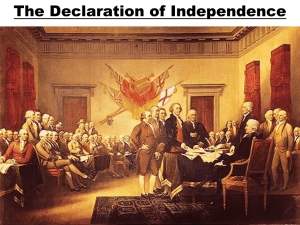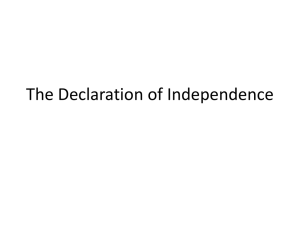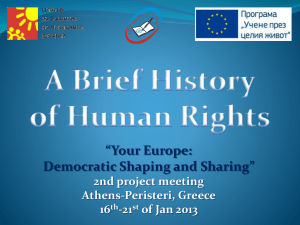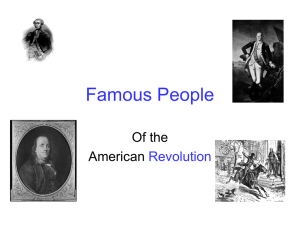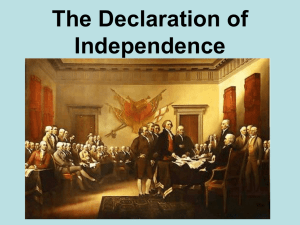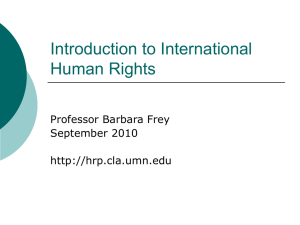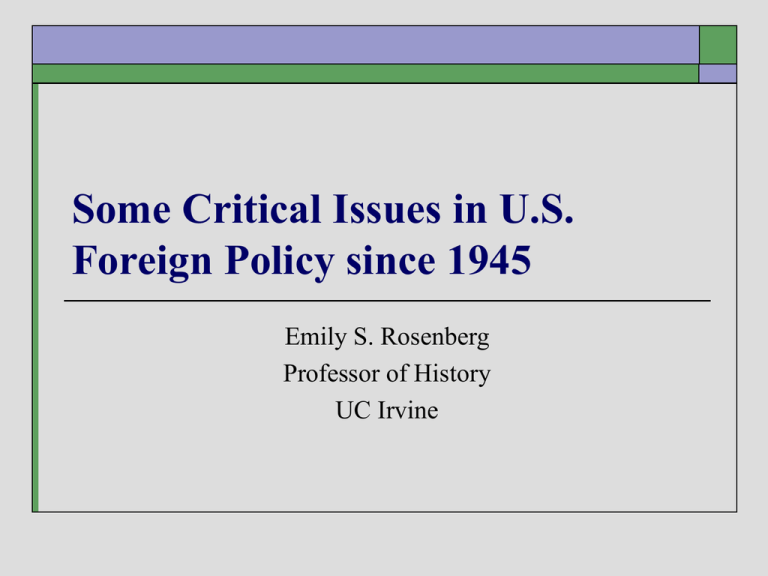
Some Critical Issues in U.S.
Foreign Policy since 1945
Emily S. Rosenberg
Professor of History
UC Irvine
Four Topics that Highlight Significant
Questions for Foreign Policy & History
A. Dropping of Atomic bomb on Japan (1945):
B. Universal Declaration of Human Rights (1948):
questions about what should count as “universal” and as a “right”
C. National Security Document-68 (1950):
questions about the advent of the atomic age
questions about new executive branch powers to wage the Cold War
D. Cold War Expositions of the 1950s:
questions about “soft” vs “hard” power
A. Truman and the Use of Atomic
Bombs against Japan
Teaching Resource:
Many photos of the bombing can be found through
Google and youtube.
This website contains an exercise that could be
adapted for classroom use in getting students to
discuss the ramifications of the use of the bomb:
http://oncampus.richmond.edu/academics/education/
projects/webquests/wwii/
A. Truman and the Use of Atomic
Bombs against Japan
Recommended Reading: J. Samuel Walker’s, Prompt and Utter Destruction: Truman and
the Use of Atomic Bombs against Japan presents a very short (110pp), readable, judicious,
and reliable examination of the controversial historical questions surrounding the use of the
bomb.
Here is his conclusion, reached after surveying all the questions under debate:
“The answer to the fundamental question that has stirred so much debate among scholars is
appropriately ambiguous. The question is, Was the bomb necessary? The answer seems to
be yes and no. Yes, it was necessary to end the war as quickly as possible. No, it was not
necessary to prevent an invasion of Japan.
A corollary to the first question is, What did the bomb accomplish? The answer seems
to be that it shortened the war and saved the lives of a relatively small but far from
inconsequential number of Americans. It might also have saved many Japanese lives,
though this was not an important consideration for U.S. policymakers. Was that sufficient
reason to wipe out two Japanese cities with weapons that delivered unprecedented military
power and unpredictable diplomatic consequences? There is no definitive answer to that
question or to a multitude of others that follow from it. But it still needs to be addressed in
an informed way by scholars, students, and other concerned citizens. The decision to use
atomic bombs against Japan was such a momentous event . . . that it should continue to be
studied, evaluated, and debated.”
Four Topics that Highlight Significant
Questions for Foreign Policy & History
A. Dropping of A-bomb (1945):
B. Universal Declaration of Human Rights (1948):
questions about what should count as “universal” and as a “right”
C. National Security Document-68 (1950):
questions about the advent of the atomic age
questions about new executive branch powers to wage the Cold War
D. Cold War Expositions of the 1950s:
questions about “soft” vs “hard” power
B. Universal Declaration of Human
Rights (1948)
1. All human beings are born free and equal in dignity and rights.They are endowed with
reason and conscience and should act towards one another in a spirit of brotherhood.
2. Everyone is entitled to all the rights and freedoms set forth in this Declaration, without
distinction of any kind, such as race, colour, sex, language, religion, political or other
opinion, national or social origin, property, birth or other status. Furthermore, no distinction
shall be made on the basis of the political, jurisdictional or international status of the country
or territory to which a person belongs, whether it be independent, trust, non-self-governing
or under any other limitation of sovereignty.
3. Everyone has the right to life, liberty and security of person..
4. No one shall be held in slavery or servitude; slavery and the slave trade shall be
prohibited in all their forms.
5. No one shall be subjected to torture or to cruel, inhuman or degrading treatment or
punishment.
6. Everyone has the right to recognition everywhere as a person before the law.
7. All are equal before the law and are entitled without any discrimination to equal
protection of the law. All are entitled to equal protection against any discrimination in
violation of this Declaration and against any incitement to such discrimination.
8. Everyone has the right to an effective remedy by the competent national tribunals for
acts violating the fundamental rights granted him by the constitution or by law.
9. No one shall be subjected to arbitrary arrest, detention or exile.
10. Everyone is entitled in full equality to a fair and public hearing by an independent and
impartial tribunal, in the determination of his rights and obligations and of any criminal
charge against him.
B. Universal Declaration of Human
Rights (1948), continued
11. Everyone charged with a penal offence has the right to be presumed innocent until proved guilty according
to law in a public trial at which he has had all the guarantees necessary for his defence.
12. No one shall be subjected to arbitrary interference with his privacy, family, home or correspondence, nor to
attacks upon his honour and reputation. Everyone has the right to the protection of the law against such
interference or attacks.
13 Everyone has the right to freedom of movement and residence within the borders of each state.
14. Everyone has the right to seek and to enjoy in other countries asylum from persecution.
15. Everyone has the right to a nationality.
16. Men and women of full age, without any limitation due to race, nationality or religion, have the right to
marry and to found a family. They are entitled to equal rights as to marriage, during marriage and at its
dissolution.
Everyone has the right to leave any country, including his own, and to return to his country.
Marriage shall be entered into only with the free and full consent of the intending spouses.
The family is the natural and fundamental group unit of society and is entitled to protection by society and the State.
17. Everyone has the right to own property alone as well as in association with others.
18. Everyone has the right to freedom of thought, conscience and religion; this right includes freedom to change
his religion or belief, and freedom, either alone or in community with others and in public or private, to manifest
his religion or belief in teaching, practice, worship and observance.
19. Everyone has the right to freedom of opinion and expression; this right includes freedom to hold opinions
without interference and to seek, receive and impart information through any media and regardless of frontiers.
20. Everyone has the right to freedom of peaceful assembly and association.
21. Everyone has the right to take part in the government of his country, directly or through freely chosen
representatives.
Everyone has the right of equal access to public service in his country.
The will of the people shall be the basis of the authority of government; this will shall be expressed in periodic and genuine
elections which shall be by universal and equal suffrage and shall be held by secret vote or by equivalent free voting
procedures.
B. Universal Declaration of Human
Rights (1948), continued
22.
Everyone, as a member of society, has the right to social security and is entitled to realization, through national effort
and international co-operation and in accordance with the organization and resources of each State, of the economic, social
and cultural rights indispensable for his dignity and the free development of his personality.
23.Everyone has the right to work, to free choice of employment, to just and favourable conditions of work and to protection
against unemployment.
24. Everyone has the right to rest and leisure, including reasonable limitation of working hours and periodic holidays with
pay.
25. Everyone has the right to a standard of living adequate for the health and well-being of himself and of his family,
including food, clothing, housing and medical care and necessary social services, and the right to security in the event of
unemployment, sickness, disability, widowhood, old age or other lack of livelihood in circumstances beyond his control.
Education shall be directed to the full development of the human personality and to the strengthening of respect for human rights and
fundamental freedoms. It shall promote understanding, tolerance and friendship among all nations, racial or religious groups, and shall further
the activities of the United Nations for the maintenance of peace.
Parents have a prior right to choose the kind of education that shall be given to their children.
27 Everyone has the right freely to participate in the cultural life of the community, to enjoy the arts and to share in scientific
advancement and its benefits.
Motherhood and childhood are entitled to special care and assistance. All children, whether born in or out of wedlock, shall enjoy the same
social protection.
26. Everyone has the right to education. Education shall be free, at least in the elementary and fundamental stages.
Elementary education shall be compulsory. Technical and professional education shall be made generally available and higher
education shall be equally accessible to all on the basis of merit.
everyone, without any discrimination, has the right to equal pay for equal work.
Everyone who works has the right to just and favourable remuneration ensuring for himself and his family an existence worthy of human
dignity, and supplemented, if necessary, by other means of social protection.
Everyone has the right to form and to join trade unions for the protection of his interests.
Everyone has the right to the protection of the moral and material interests resulting from any scientific, literary or artistic production of
which he is the author.
28. Everyone is entitled to a social and international order in which the rights and freedoms set forth in this Declaration can
be fully realized.
29. Everyone has duties to the community in which alone the free and full development of his personality is possible.
In the exercise of his rights and freedoms, everyone shall be subject only to such limitations as are determined by law solely for the purpose
of securing due recognition and respect for the rights and freedoms of others and of meeting the just requirements of morality, public order
and the general welfare in a democratic society.
These rights and freedoms may in no case be exercised contrary to the purposes and principles of the United Nations.
Who was Eleanor Roosevelt?
Franklin
Roosevelt’s wife
Delegate to UN
after FDR’s death
Led effort to pass
a Universal
Declaration
B. Universal Declaration of Human
Rights (1948)
Example of arguments on behalf of Declaration:
Eleanor Roosevelt: Address to the United Nations General Assembly, Dec., 1948 at
http://www.americanrhetoric.com/speeches/eleanorrooseveltdeclarationhumanrights.htm
My Government has made it clear in the course of the development of the Declaration that it
does not consider that the economic and social and cultural rights stated in the Declaration
imply an obligation on governments to assure the enjoyment of these rights by direct
governmental action. . . . This in no way affects our whole-hearted support for the basic
principles of economic, social, and cultural rights set forth in these articles.
In giving our approval to the Declaration today it is of primary importance that we keep
clearly in mind the basic character of the document. It is not a treaty; it is not an
international agreement. It is not and does not purport to be a statement of of law or of legal
obligation. It is a Declaration of basic principles of human rights and freedoms, to be
stamped with the approval of the General Assembly by formal vote of its members, and to
serve as a common standard of achievement for all peoples of all nations.
We stand today at the threshold of a great event both in the life of the United Nations and in
the life of mankind. This Universal Declaration of Human Rights may well become the
international Magna Carta of all men everywhere. We hope its proclamation by the General
Assembly will be an event comparable to the proclamation of the Declaration of the Rights
of Man by the French people in 1789, the adoption of the Bill of Rights by the people of the
United States, and the adoption of comparable declarations at different times in other
countries.
B. Universal Declaration of Human
Rights (1948)
Example of arguments against Declaration:
1. Glenn Wiceshyn, “United Nations Declaration of Human Rights Destroys Individual
Rights” (December 11, 1998 at http://capmag.com/article.asp?ID=210
The declaration first covers what appear to be legitimate rights, such as "the right to life,
liberty and security of person," "the right to own property," and freedom of "thought" and
"opinion." (The right to pursue happiness is absent, for reasons that will soon become
obvious.) It then introduces a series of "economic rights," such as a person's "right" to work,
paid holidays, protection against unemployment, social security, free education, and a
standard of living adequate for the health and well-being of himself and of his family,
including food, clothing, housing and medical care .
If people are entitled to these, who will be forced to provide them? Whose property will be
seized to pay for them?
Such "economic rights" obviously contradict the right to liberty and property. There can be
no such thing as a right to violate the rights of others. "Economic rights" merely hand
government the power to violate individual rights, thereby rendering the individual a slave
to the needs and desires of others. They effectively make communism the social ideal.
2. In 1981, the Iranian representative to the United Nations, Said Rajaie-Khorassani,
articulated the position of his country regarding the Universal Declaration of Human Rights,
by saying that the UDHR was a "a secular understanding of the Judeo-Christian tradition",
which could not be implemented by Muslims without trespassing Islamic law.
B. Universal Declaration of Human
Rights (1948)
Recommended Reading:
Elizabeth Borgwardt, A New Deal for the World: America's Vision for Human Rights
(Harvard, 2005) describes how a cadre of World War II American planners inaugurated the
ideas and institutions that underlie our modern international human rights regime.
Borgwardt finds the key in the 1941 Atlantic Charter and its Anglo-American vision of "war
and peace aims." In attempting to globalize what U.S. planners heralded as domestic New
Deal ideas about security, the ideology of the Atlantic Charter--buttressed by FDR's "Four
Freedoms" and the legacies of World War I--redefined human rights and America's vision
for the world.
Three sets of international negotiations brought the Atlantic Charter blueprint to life-Bretton Woods, the United Nations, and the Nuremberg trials. These new institutions set up
mechanisms to stabilize the international economy, promote collective security, and
implement new thinking about international justice. The design of these institutions served
as a concrete articulation of U.S. national interests, even as they emphasized the importance
of working with allies to achieve common goals. The American architects of these charters
were attempting to redefine the idea of security in the international sphere. To varying
degrees, these institutions and the debates surrounding them set the foundations for the
world we know today.
Borgwardt’s study illuminates the New Deal’s vision of modern human rights, trade and the
global economy, collective security, and international law.
Four Topics that Highlight Significant
Questions for Foreign Policy & History
A. Dropping of A-bomb (1945):
B. Universal Declaration of Human Rights (1948):
questions about what should count as “universal” and as a “right”
C. National Security Document-68 (1950):
questions about the advent of the atomic age
questions about new executive branch powers to wage the Cold War
D. Cold War Expositions of the 1950s:
questions about “soft” vs “hard” power
C. National Security Document-68
(1950)
This once top-secret document was drawn up by President Harry
Truman’s staff to provide an overall plan for fighting communism in the
Cold War. Its recommendations, associated with a policy called
“containment,” came to be implemented under the pressure of the Korean
War, which seemed to provide evidence of the “Kremlin design” for
expansion.
The full text of NSC-68 (over 50 pages) is posted on site of the Federation
of American Scientists at http://www.fas.org/irp/offdocs/nsc-hst/nsc68.htm .
The excerpt below illustrates the broad new executive branch powers that
were developed during the early Cold War. What are these new powers
and what have been some of their long-term effects?
Recommended Reading: See Melvyn Leffler, The Specter of Communism
for more context.
C. National Security Document-68
(1950)
“A comprehensive and decisive program to win the peace and frustrate the Kremlin design should be so
designed that it can be sustained for as long as necessary to achieve our national objectives. It would
probably involve:
The development of an adequate political and economic framework for the achievement of our long-range
objectives.
A substantial increase in expenditures for military purposes adequate to meet the requirements for the tasks
listed in Section D-1.
A substantial increase in military assistance programs, designed to foster cooperative efforts, which will
adequately and efficiently meet the requirements of our allies for the tasks referred to in Section D-l-e.
Some increase in economic assistance programs and recognition of the need to continue these programs until
their purposes have been accomplished.
A concerted attack on the problem of the United States balance of payments, along the lines already
approved by the President.
Development of programs designed to build and maintain confidence among other peoples in our strength
and resolution, and to wage overt psychological warfare calculated to encourage mass defections from Soviet
allegiance and to frustrate the Kremlin design in other ways.
Intensification of affirmative and timely measures and operations by covert means in the fields of economic
warfare and political and psychological warfare with a view to fomenting and supporting unrest and revolt in
selected strategic satellite countries.
Development of internal security and civilian defense programs.
Improvement and intensification of intelligence activities.
Reduction of Federal expenditures for purposes other than defense and foreign assistance, if necessary by the
deferment of certain desirable programs.
Increased taxes.
C. National Security Document-68
(1950), continued
“From the point of view of the economy as a whole,
the program might not result in a real decrease in the
standard of living, for the economic effects of the
program might be to increase the gross national
product by more than the amount being absorbed for
additional military and foreign assistance purposes.
One of the most significant lessons of our World War
11 experience was that the American economy, when
it operates at a level approaching full efficiency, can
provide enormous resources for purposes other than
civilian consumption while simultaneously providing
a high standard of living.”
Four Topics that Highlight Significant
Questions for Foreign Policy & History
A. Dropping of A-bomb (1945):
B. Universal Declaration of Human Rights (1948):
questions about what should count as “universal” and as a “right”
C. National Security Document-68 (1950):
questions about the advent of the atomic age
questions about new executive branch powers to wage the Cold War
D. Cold War Expositions of the 1950s:
questions about “soft” vs “hard” power
D. Cold War Expositions of the 1950s
What is “hard” vs “soft” power? (See Joseph
Nye, Soft Power)
U.S. Expositions abroad during the 1950s
aimed to convince the world of the superiority
of the “American Way of Life”
Let’s look at some photos and talk about some
of the elements of this “American Way”
Brussels Exposition, 1958
U.S. Pavilion in Brussels, 1958
Soviet
Pavilion,
Brussels
Interior of US Pavilion: Fashion Show with People Watching?
Practice for U.S. Fashion Show,
Brussels, 1958
Lee Canfield (sister of Jacqueline
Kennedy) orchestrated the Vogue
Fashion show called the
“Young America Look”
American Culture as a
Culture of Transformation
And “Self-fashioning”?
Brussels Exposition, 1958
Workers look through US mail order catalog
The Sears Roebuck catalog was especially
popular in Brussels
Snack Bar and Ice Cream Parlor
Russians try on “propeller beanies”
Children's Creative Center,
sponsored by the
Museum of Modern Art,
in the American Pavillion,
Brussels World's Fair.
Kitchen in Soviet Pavilion
Highly advertised U.S. kitchens
Modern kitchens are one of the most important
weapons in the “psychological battle to win the
uncommitted nations to the free way of life. . . .It is
one of the wonders of the world that Americans in
every economic strata have kitchens with laborsaving devices which free the American woman
from drudgery, which make the kitchen the heart of
the home.” – Katherine Howard (2nd deputy
commissioner of the exhibition).
American Exposition, Moscow 1959
Vogue magazine
Vogue Magazine, Coty
Cosmetics, and Helena
Rubenstein were partners
with US Information
Agency at Cold War
Expositions in
Brussels in 1958 and
Moscow in 1959
Vogue Fashions in Moscow, 1959
Ranch-style home of 1950s
American Exposition,
Moscow, 1959
V.P. Nixon and Khrushchev in
Kitchen Debate, 1959
“Put me to the test” at
http://www.youtube.com/watch?v
=UjrYtQ_iMGY
Consider the role of Hollywood
films, popular throughout the world, in
spreading ideas about the U.S.
“The NYLON War”
In 1951, American sociologist David Riesman
published a satiric essay entitled "The Nylon
War", in which he envisioned an American
aerial offensive to bombard Soviet citizens
with consumer goods, ranging from "nylon
hose" to radios and even jeeps.
[full text can be found through Google-books]
Some Conclusions
The Cold War is often cast as a story of high politics:
military and diplomatic confrontation.
But it was also waged at the cultural level in ways
that equated attributes of American culture and an
“American Look” with modernity and freedom.
Maybe these appeals were ultimately critical to
winning the Cold War. . . . Could David Riesman’s
idea have saved us a lot of money?
Some Questions to Consider
Does the U.S. still project the codes that signal useful cultural
capital in the world?
Will the decline in U.S. economic power and influence mean
a decline in America’s cultural capital?
Brad DeLong, a UCB economist, argues that cultural power
stems from economic strength: See next two slides.
http://www.foreignpolicy.com/articles/2009/12/23/the_end_of
_influence?page=full
“Soft power -- not military might, not straight-out money, but the ability to inspire
acceptance and imitation -- was a vital component of American international dominance.
Money, of course, is power. Because America had the money -- had it solidly, rightfully, selfassuredly, and durably -- for about 100 years, people all over the world wanted to be like
Americans: successful, modern, loose-jointed, efficient, democratic, socially mobile, leggy,
clean, powerful, and, of course, rich. Money brings a nation power;it brings the power to
propagate, consciously or not, the ideas, concerns, fashions, norms, interests, amusements,
and ways of displaying and behaving that come out of its culture. These penetrate deep down
into other cultures as well as its own; they become part of daily life. This is luxuriant power:
It doesn't have to be exercised willfully or even consciously, and it doesn't even cost anything
extra. It was clearly the way to be.
As the United States emerged in the aftermath of World War I as the top power and giant
money master, American jazz swept through Europe, faster than Ford and Kodak. Later,
especially after World War II, Europeans eagerly welcomed the onslaught of American
movies. Most Europeans encountered America at the movies, but two generations of rather
privileged Europeans traveled to America to see for themselves (many sponsored by the State
Department), to behold the skyscrapers of New York, the George Washington and Golden
Gate bridges, and the houses of rather ordinary people with huge shiny cars, washing
machines, televisions, and the orthodontically enhanced smiles on tall, milk- and meat-fed
women.”
From Brad De Long, End of Influence?
continued:
“American cultural dominance has continued to grow. Teenagers around the globe now
uniformly dress in styles pioneered by American teens and have even adopted the same
body language. They eat on the street. The American-designed, Asian-manufactured iPods
fill their heads with the same harsh music; they instant-message, blog, and Tweet. And the
English language -- not altogether an American cultural invention -- is not merely the
international language, but also the second language for a vast global population:
Languages carry more than their words and grammar; they carry cultural form and content.
America will be less and less the origin of new cultural trends or global memes: First,
because the others now have the money. But also, because while America remains
especially modern, the modern is no longer especially American; it is rapidly becoming
semiglobal and if not old, at least very mature.”


